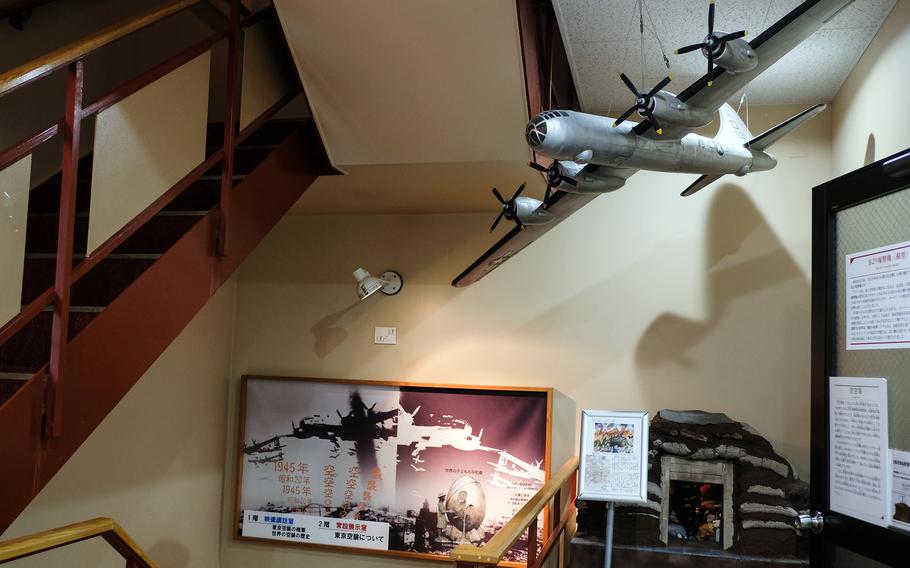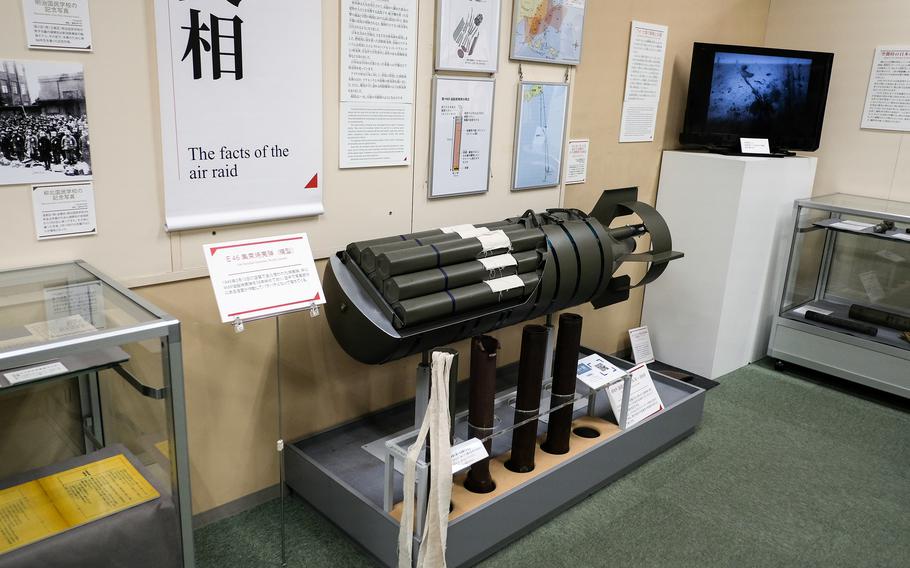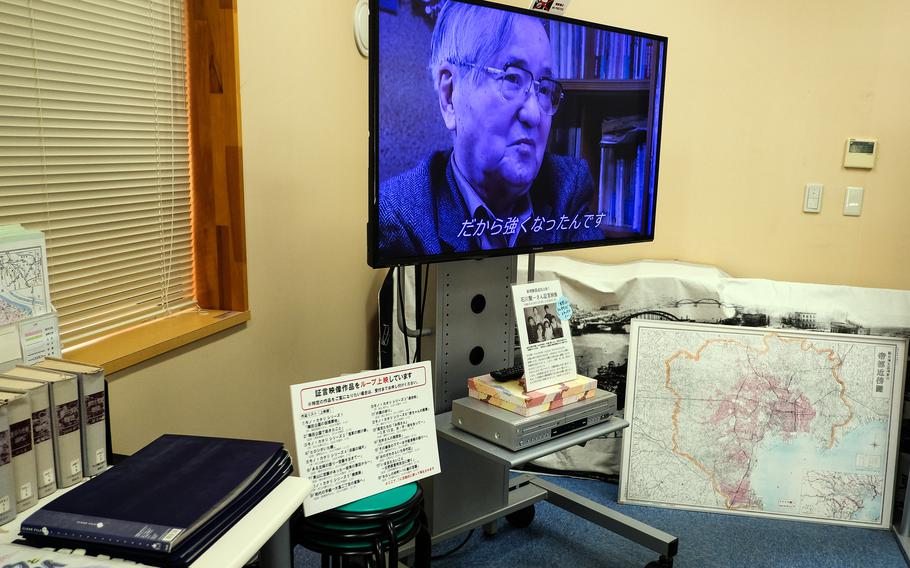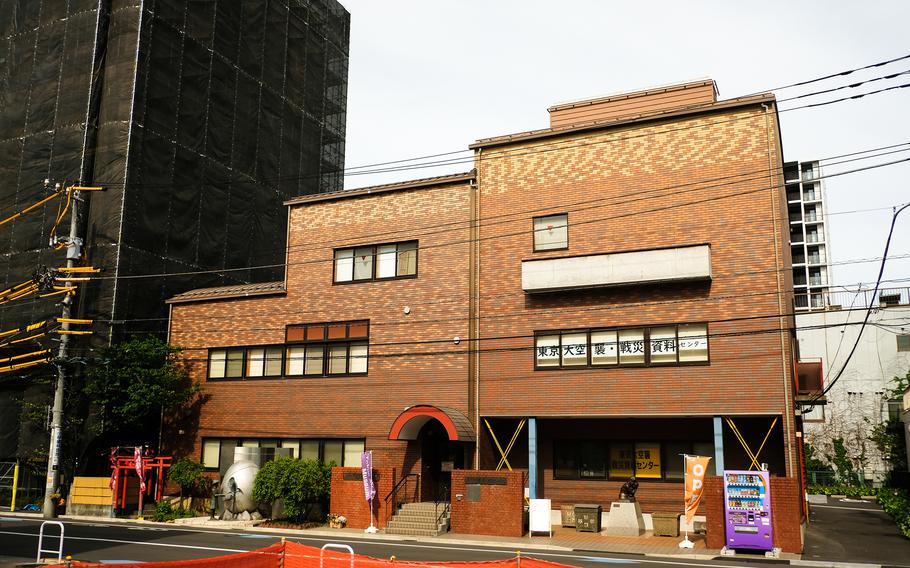
A model of a U.S. B-29 Superfortress bomber hangs over a model of a Japanese civilian bomb shelter at the Center of the Tokyo Raids and War Damage in Tokyo, April 22, 2025. (Joshua L. DeMotts/Stars and Stripes)
Along an unassuming street in the Koto city section of Tokyo sits a modest, three-story, red-brick building that gradually grows lighter in color toward the top, as if it were on fire.
Inside, the privately owned and operated Center of the Tokyo Raids and War Damage was established largely by the efforts of Katsumoto Saotome, a survivor of the World War II firebombing of Tokyo by U.S. Army Air Forces. It opened its doors on March 9, 2002.
The early-morning incendiary bombing raid on March 10, 1945 — codenamed Operation Meetinghouse — created a firestorm in the city, killed an estimated 100,000 people and left more than 1 million homeless. Half of the city was destroyed.
Eighty years later, the Great Tokyo Air Raid is overshadowed in history by the atomic bombings of Hiroshima and Nagasaki.
A group of Tokyo bombing survivors using private donations created the nondescript Center of the Tokyo Raids and War Damage to raise awareness and preserve their stories.
The center also encourages public debate about the tactic of firebombing civilian populations and the fear of history repeating itself.
Once inside the center, visitors enter a lobby and small library where one can quietly read about and look at pictures to reflect on the Great Tokyo Air Raid.

Models of and real remnants of the incendiary bombs used in the Great Tokyo Air Raid are displayed at the Center of the Tokyo Raids and War Damage in Tokyo, April 22, 2025. (Joshua L. DeMotts/Stars and Stripes)
A first-floor video and lecture room is used for screenings and events. The lecture room displays a large air raid damage map of Tokyo, a timeline of air raids up to the present day, and heart-wrenching artwork depicting scenes from that deadly night.
Atop the stairway to the main exhibition room, a model of a U.S. B-29 Superfortress bomber is suspended over a model of a civilian air raid shelter created by Tokyo firebombing survivor Haruyo Nihei.
The exhibits are organized into four sections, beginning with Daily Life Under the Wartime, illustrating how the Japanese lived and prepared for war, and The Facts of the Air Raids, which displays real and model incendiary bombs, artwork and testimonials of the experience.
The Video Reference Library is an audio-visual room that plays videos of air raid survivors recounting their stories. Finally, the Revival from the Air Raids section chronicles the after-effects of the air raid that continued long after the war.

An air raid survivor recounts his story in the video library at the Center of the Tokyo Raids and War Damage in Tokyo, April 22, 2025. (Joshua L. DeMotts/Stars and Stripes)
Hanging in the hallway outside the main exhibit hall are photographs of the Ukraine conflict, raising awareness of current wars and suffering.
The center is sustained and managed by membership fees and public donations and provides several convenient ways to donate on site or online.
Most of the exhibits have descriptions in English, and an English floor map is also provided.
While not as well-known and grand as the atomic bomb memorials and museums, the Center of the Tokyo Raids and War Damage offers a place to remember the lives lost that night, and by considering the ethics of air raids in any conflict.

The Center of the Tokyo Raids and War Damage encourages public debate about the tactic of firebombing civilian populations and the fear of history repeating itself. (Joshua L. DeMotts/Stars and Stripes)
On the QT
Directions: 136-0073 1-5-4 Kitasuna, Koto, Tokyo; a 20-minute walk from Sumiyoshi Station on the Shinjuku Line.
Times: Open 10:30 a.m. to 4 p.m. Tuesday through Sunday.
Costs: Adults, 300 yen; junior high students and older, 200 yen; elementary school student, 100 yen; free for preschoolers and those with disabilities.
Food: You’ll find restaurants and cafes in the surrounding neighborhood.
Information: Online: tokyo-sensai.net/english